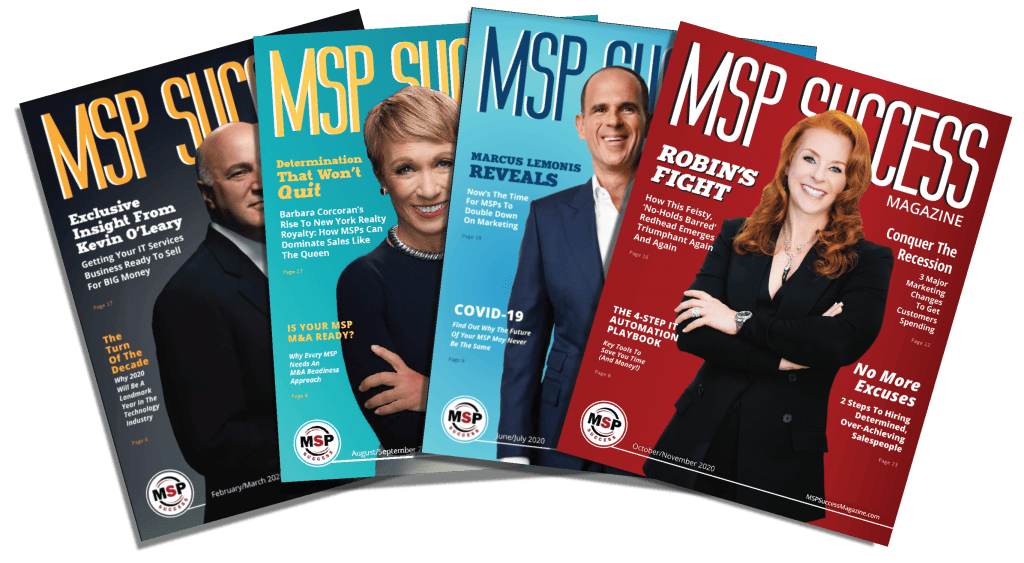The Pumpkin Plan For Managed Service Providers: The Roadmap to MSP Prosperity, is a licensed derivative of The Pumpkin Plan by Mike Michalowicz, who wrote the Foreword. The Pumpkin Plan resonated with the MSP community from the get-go, and business coaches and former MSPs Dave Cava and Shawn Walsh have now overlayed this derivative with their own experiences and lessons learned. Certified Pumpkin Plan coaches, they offer an MSP-specific blueprint for executing the plan.
In this excerpt from The Pumpkin Plan for Managed Service Providers, the authors break down how weeding out bad clients can seriously boost your profits and reduce stress on your team. This excerpt is condensed and edited for clarity.
What’s Your Stress Per Dollar?
As an MSP business owner, when you consider clients and prospects, you should be thinking beyond whether their money is green. If not, by taking them on, you may be missing out on the chance to bring on a different client who’s a much better fit.
The concept of opportunity cost is very real. Your resources are finite. If you spend your time and attention on clients who aren’t worth it, then you’re wasting time and energy; you and your company only have so much of that to spend.
The worst clients aren’t very profitable, suck up a lot of time, keep you distracted, and sap energy from the team. Eventually, they can scare off an MSP’s best people.
We have an imaginary nonsense metric we talk about called “stress per dollar.” If every time your team works with a particular client, they just want to bang their heads on the wall, that would be a high stress-per-dollar client. We have a saying: “You get to be cheap OR a pain in the ass.” MSPs should avoid ever bringing on a client who is both of those things. If it’s too late for that, you’ll need to whip them into shape or cut them out of your business.
Conduct A Ruthless Inventory
To do a client inventory, create a simple spreadsheet with information like:
- Total service revenue by client for the last 12 months
- How much of that revenue is MRR vs. projects and hourly billing
- Number of hours you’ve spent on each client (including non-billable time) over the last 12 months
- Average user count for each client for the last 12 months
With these numbers, you can easily create the following useful metrics:
Percentage of service revenue that is MRR. Ideally, you want this number to be over 75%, but not 100%. The other 25% or less is for projects and out-of-scope work. If clients are at 100% MRR, then projects are likely going undone or being done for free.
Effective hourly rate. This simple calculation shows how much is really being made per hour.This number should be higher than what you would have charged for hourly services when …
- The client is on a managed services plan that is priced correctly.
- Their technology is aligned with the MSP’s standard stack.
- The users are competent, reasonable people.
Hours per user per month. This number can reveal a lot about the efficiency of an MSP’s team and tools. The MSP’s clients are basically using the same team that is using the same tools, so for this exercise, all you really care about is how clients compare to each other. This number will show which clients are a drain on resources.
Rank Your Clients
Armed with this information, you can build your assessment chart. Start by ranking clients in order by amount of revenue.
Then put each client into one of three categories:
“Yes” clients. These are low-stress and high-profit. They are on a standard managed services deal (the one you want to sell to everyone). These people are good to work with, and their technology aligns well with your stack of choice.
“No” clients. These obviously have no real potential. They don’t take advice, and often make their technology decisions without your involvement. They are not very profitable and probably never will be, and there isn’t much of a relationship to build on. These clients must go!
“Change or die” clients. These clients have the potential to stay on your list, but they’re not there yet. Perhaps they are still primarily on hourly billing, or if they are on flat fees, they require too much time and attention to really be profitable. Maybe you have been able to get part of your technology stack in there, but some key elements are still out of line. Eventually, they need to get with the program or get gone.
Start To Weed
The best way for an MSP to start weeding the garden is by going up to the biggest, ugliest weed they can find and ending its life. If you were to divide your clients into A List, B List, and C List, then this is the D List. They are the worst offenders—absolutely cheap and a pain in the ass. Their technology is a ticking time bomb, and they don’t treat your team well. Cut them first.
How To Swing The Axe
In some cases, the MSP may just simply inform the client they will no longer be servicing them (with a proper notice period like 30 to 60 days). If a contract is in place, the notice period in that agreement should be honored, naturally. To whatever degree possible, you should try to exit with reputation intact.
Here are a few ways to fire clients besides, “You’re a big jerk and we don’t make money on you.” These methods will work both to cut ties with “No” clients and kickstart the process with your “Change or Die” clients.
Eliminate Billing Plans. Do you have clients you’d like to shed who you believe will never move off hourly billing? Tell them you are no longer supporting time-and-materials clients, and you’d be happy to find them a vendor who is a better fit for their needs. Now, if they want to upgrade their technology to your stack and stay on as a fully managed client with automated payment on the first of the month, that’s cool. But many won’t do that.
Limit The Technologies You Support. Chances are pretty good that an MSP’s worst clients have not fully adopted their technology stack and never will. Are they resistant to pay for the level of security you require? You’ve got an easy out. Kindly and gently (but firmly) give them notice according to the terms of your contract.
Raise Prices. We’re not talking about a cost-of-living increase here. Raise them significantly—enough so that these clients are likely to run away. Buh-bye! If they stick around and pay 50% more, that’s a win too. They just went from being cheap AND a pain in the ass to being highly profitable and a pain in the ass—that’s much better. If they still aren’t worth keeping around, raise their prices again in six months. Then again.
Lower Their Service Level. Make a sh*t list. Put your C-List clients on it. Then tell them they are on it. (Maybe don’t call it “The Sh*t List” when you’re explaining things.) Let them know that clients who align with your technical standards and preferred service offering will be getting priority service and that those on the sh*t list will always be at the back of the line when something goes wrong. Sh*t-list clients get no service level agreement. You’ll get to them when you get to them, and you have no obligation whatsoever to get to them in any defined timeframe. From here out, bad clients get treated like bad clients.
Give Bad Clients To Your Competitors. You should now have a list of low-profit or no-profit clients. Start with the no-profit ones. Those are presently worthless to you. They don’t value your services. They are tolerating you because you are a cheap form of financing, or worse, you are the only one who puts up with their abusive behavior toward your staff. Sending these clients off to competitors will create more opportunity for you in the end.
You’ll notice that all these methods have something in common: You are taking back control of subpar client relationships. Now, because of your bold action, those dysfunctional client relationships will either be healthier, or they will go away. Either way, you’ll be able to spend more time on profitable clients, decrease risk for your clients and MSP, and reduce stress for yourself and your team.
Love this excerpt? Find more great advice and profitability tips in the full version of The Pumpkin Plan for MSPs.














